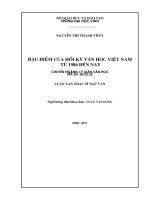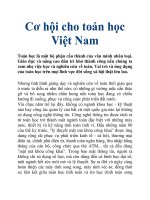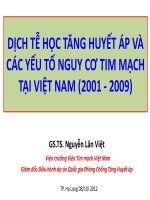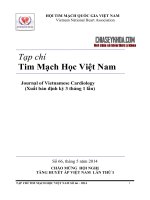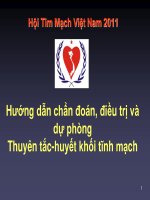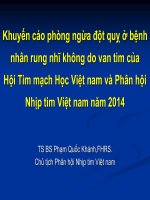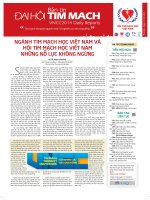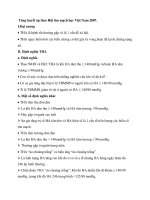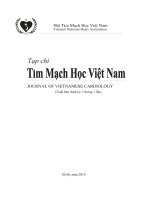Hội Tim mạch học Việt Nam
Bạn đang xem bản rút gọn của tài liệu. Xem và tải ngay bản đầy đủ của tài liệu tại đây (3.84 MB, 51 trang )
<span class='text_page_counter'>(1)</span><div class='page_container' data-page=1>
<b>ATRIAL FIBRILLATION ABLATION</b>
</div>
<span class='text_page_counter'>(2)</span><div class='page_container' data-page=2>
<b>Atrial Fibrillation (AF)</b>
• Chaotic and disorganized atrial activity
• Irregular heartbeat
• Can be paroxysmal, persistent or
permanent (chronic)
• Most common sustained arrhythmia
• Can be symptomatic or asymptomatic
</div>
<span class='text_page_counter'>(3)</span><div class='page_container' data-page=3>
<b>Atrial Fibrillation</b>
</div>
<span class='text_page_counter'>(4)</span><div class='page_container' data-page=4>
<b>Forms of Atrial Fibrillation</b>
• Paroxysmal
– Paroxysmal lasting less than 7 days, self- terminating
• Persistent
– An episode of AF lasting greater than 7 days, which can still
be cardioverted to sinus rhythm
• Permanent
</div>
<span class='text_page_counter'>(5)</span><div class='page_container' data-page=5>
<b>Associated Diseases</b>
• Hypertension
• Coronary heart
disease
• Valvular heart
disease
• Cardiomyopathy
• Sick sinus
syndrome
• Congenital heart
disease
• Cardiac surgery
</div>
<span class='text_page_counter'>(6)</span><div class='page_container' data-page=6>
<b>AF AND HEART FAILURE</b>
<i>AF decreases cardiac outflow :</i>
- loss of atrial systole
- shortening of diastole
- irregularity of ventricular cycle
- difficulty with valve closure
<i>AF worsens coronary disaese :</i>
- tachycardia increases O2 consumption
- shortening of diastole
<i>AF worsens heart failure :</i>
</div>
<span class='text_page_counter'>(7)</span><div class='page_container' data-page=7>
<b>Prevalence of AFib</b>
<b>General population-based </b>
<b>prevalence</b>
<b>0.95%</b>
<i>Go AS, et al. JAMA (2001) 285: 2370</i>
<b>ATRIA study</b>
<b>2.5%</b>
<b>Olmsted County study</b></div>
<span class='text_page_counter'>(8)</span><div class='page_container' data-page=8>
<b>Prevalence of AFib</b>
Olmsted County study
<b>Proj</b>
<b>ec</b>
<b>ted</b>
<b> numb</b>
<b>er</b>
<b> of p</b>
<b>er</b>
<b>sons </b>
<b>wi</b>
<b>th </b>
<b>AF </b>
(mil
lio
n
s)
2000
<b>Year</b>
2005 2010 <sub>2015 2020</sub> 2025 2030 2035 2040 2045 2050
0
16
14
10
6
2
12
8
<b>5.1</b>
<b>15.9</b>
<b>15.2</b>
<b>14.3</b>
<b>13.1</b>
<b>11.7</b>
<b>10.2</b>
<b>8.9</b>
<b>7.7</b>
<b>5.9</b> <b>6.7</b>
4 <b><sub>5.1</sub></b>
<b>12.1</b>
<b>11.7</b>
<b>11.1</b>
<b>10.3</b>
<b>9.4</b>
<b>8.4</b>
<b>7.5</b>
<b>6.8</b>
<b>5.6</b> <b>6.1</b>
</div>
<span class='text_page_counter'>(9)</span><div class='page_container' data-page=9>
<b>Increased Risk of Cardiovascular Events</b>
<i>Stewart S, et al. Am J Med (2002) 113: 359</i>
<b>At </b>
<b>least</b>
<b> o</b>
<b>ne </b>
<b>CV </b>
<b>eve</b>
<b>nt</b>
<b> (</b>
%
)
AFib No AFib
0
20
40
80
100
<b>45</b>
60
<b>66</b>
AFib No AFib
<b>27</b>
<b>89</b>
Men Women
</div>
<span class='text_page_counter'>(10)</span><div class='page_container' data-page=10>
80
60
40
20
0
<b>Mortality Associated with AFib</b>
2
0 1 3 4 5 6 7 8 9 10
<b>Framingham Heart Study, n=5209</b>
<i>Benjamin EJ, et al. Circulation (1998) 98: 946</i>
</div>
<span class='text_page_counter'>(11)</span><div class='page_container' data-page=11>
<b>AFib-FOR WHOM?</b> <b>(</b><i><b>Paroxysmal or Persistent</b></i><b>)</b>
<b>1.</b> <i><b>AF w/ “significant symptoms” associated</b></i>
<b>2.</b> <b>Refractory to AADs</b>
<b>3.</b> <b>Absence of severe structural heart dz</b>
<b>HOW?</b>
<b>1.</b> <b>Electrical isolation of pulmonary veins</b>
<b>2.</b> <b>Atrial tissue substrate modification</b>
<b>3.</b> <b>Accomplished via catheter ablation, combined if </b>
<b>possible w/ multiple imaging modalities</b>
</div>
<span class='text_page_counter'>(12)</span><div class='page_container' data-page=12>
<b>AFib</b>
• Anatomy
• Electrophysiologic Characteristics
</div>
<span class='text_page_counter'>(13)</span><div class='page_container' data-page=13></div>
<span class='text_page_counter'>(14)</span><div class='page_container' data-page=14>
<b>Right atrium</b> <b>Left atrium</b>
<b>17</b> <b><sub>31</sub></b>
<b>11</b>
<b>6</b>
<b>Superior</b>
<b>caval Vein</b>
<b>Inferior </b>
<b>caval vein</b>
<b>Fossa</b>
<b>ovalis</b>
<b>Coronary</b>
<b>Sinus</b>
</div>
<span class='text_page_counter'>(15)</span><div class='page_container' data-page=15>
AP
</div>
<span class='text_page_counter'>(16)</span><div class='page_container' data-page=16>
<b>… critical zone</b>
<b>Sueda </b>
<b>Ann Thorac Surg 1997</b>
<b>Microreeentrant </b>
<b>circuits</b>
<b>Haissaguerre</b>
<b>NEJM 1998</b>
<b>PV foci</b>
<b>LOM</b>
<b>Hwang</b>
</div>
<span class='text_page_counter'>(17)</span><div class='page_container' data-page=17></div>
<span class='text_page_counter'>(18)</span><div class='page_container' data-page=18>
<b>Ablation of AFib </b>
<b>-Techniques</b>
<b>Trigger approach:</b>
• Focal (within PV)
• Segmental ostial
• <b>Tailored approach </b>
<b>Substrate approach:</b>
• Circumferential atrial
• Additional lines (roof, mitral
isthmus)
• Substrate mapping (CAFE,
DF)
</div>
<span class='text_page_counter'>(19)</span><div class='page_container' data-page=19></div>
<span class='text_page_counter'>(20)</span><div class='page_container' data-page=20></div>
<span class='text_page_counter'>(21)</span><div class='page_container' data-page=21></div>
<span class='text_page_counter'>(22)</span><div class='page_container' data-page=22></div>
<span class='text_page_counter'>(23)</span><div class='page_container' data-page=23>
Identification of the left mitral appendage ridge
<b>Endocardial Section Before and After </b>
<b>RF Ablation - LPV</b>
Courtesy of Professor Antonio Raviele, Mestre, Italy
<b>LAp</b>
<b>LUPV</b>
<b>LLPV</b>
<b>LAp</b>
<b>LUPV</b>
</div>
<span class='text_page_counter'>(24)</span><div class='page_container' data-page=24>
<b>RLPV</b>
<b>RMPV</b>
<b>RUPV</b>
<b>RLPV</b>
<b>RMPV</b>
<b>RUPV</b>
<b>Endocardial Section Before and After </b>
<b>RF Ablation - RPV</b>
</div>
<span class='text_page_counter'>(25)</span><div class='page_container' data-page=25>
<b>LLPV</b>
<b>LUPV</b>
<b>RUPV</b>
<b>RLPV</b>
<b>RMPV</b>
<b>AC</b>
<b>LA</b>
<b>PV Antrum Isolation Guided by </b>
<b>CARTOMERGE™ Image Integration Software </b>
<b>Module</b>
</div>
<span class='text_page_counter'>(26)</span><div class='page_container' data-page=26>
<b>PV-Ablation extraostial </b>
</div>
<span class='text_page_counter'>(27)</span><div class='page_container' data-page=27></div>
<span class='text_page_counter'>(28)</span><div class='page_container' data-page=28>
Linear 443 75% 26% 33% 55%
Focal 508 81% 35% 54% 71%
Isolation 2,187 83% 36% 62% 75%
Circumferential (all) 15,455 68% 37% 64% 74%
Circumferential
(LACA, WACA) 2,449 65% 37% 59% 72%
Circumferential
(PVAI) 11,132 68% 42% 67% 76%
Substrate ablation
(CFAE) 559 51% 49% 75% 87%
TOTAL 23,626 61% 55% 63% 75%
Patients Paroxysmal AF <sub>6-month cure 6-months OK</sub>
<b>Ablation method</b> SHD
<i>Fisher JD, et al. PACE (2006) 29: 523</i>
<b>Meta-analysis of Catheter Ablation Studies (I)</b>
Cure (by each author’s criteria) means no further AFib 6 months after the procedure in the
absence of AAD.
</div>
<span class='text_page_counter'>(29)</span><div class='page_container' data-page=29>
No structural HD 1,026 86% 3% 81% 72%
Structural HD 350 29% 100% 74% 79%
Paroxysmal AFib 3,880 100% 23% 64% 73%
Persistent –
Permanent AFib 3,741 0% 82% 66% 74%
Patients Paroxysmal AFib <sub>6-month cure 6-months OK</sub>
<b>Condition / Type of </b>
<b>AFib</b> SHD
<i>Fisher JD, et al. PACE (2006) 29: 523</i>
<b>Meta-analysis of Catheter Ablation Studies (II)</b>
Cure (by each author’s criteria) means no further AFib 6 months after the procedure in the
absence of AAD.
</div>
<span class='text_page_counter'>(30)</span><div class='page_container' data-page=30>
<b>Worldwide Survey on Efficacy and Safety of Catheter </b>
<b>Ablation for AFib</b>
•
Total success rate: 76%
• <b>Of 8745 patients:</b>
– 27.3% required 1 procedure
– 52.0% asymptomatic without drugs
– 23.9% asymptomatic with an AAD within <1 yr
• Highly variable outcome between centres
</div>
<span class='text_page_counter'>(31)</span><div class='page_container' data-page=31>
Ouyang
et al 2004 41 63 ± 9 100 NA
<b>CART</b>
<b>O</b>
<b>PV </b>
<b>Isolation</b> 76 178
Haïssaguerre
et al 2004 70 53 ± 8 NA 43 <b>Fluoro</b>
<b>PV </b>
<b>Isolation</b> 79 210
Mansour
et al 2004 40 55 ± 10 80 13
<b>CART</b>
<b>O</b>
<b>PV </b>
<b>Isolation</b> 75 330
Marrouche
et al 2003 259 54 ± 11 51 21 <b>ICE</b>
<b>PV </b>
<b>Isolation</b> 87 347
Oral
et al 2003 40 54 ± 11 100 3
<b>CART</b>
<b>O</b>
<b>EGM </b>
<b>Reduction</b> 88 365
Pappone
et al 2003 589 65 ± 9 69 6
<b>CART</b>
<b>O</b>
<b>EGM </b>
<b>Reduction</b> 79 861
Total 1039 81.0
Year Follow-up Follow-up,d
AF Free
(Off drugs),
%
Study Age, y Parox,% SHD,% Tool(s) End point
<b>Results from Pioneering Centres </b>
<i>Verma A & Natale A Circulation (2005) 112: 1214</i>
</div>
<span class='text_page_counter'>(32)</span><div class='page_container' data-page=32></div>
<span class='text_page_counter'>(33)</span><div class='page_container' data-page=33></div>
<span class='text_page_counter'>(34)</span><div class='page_container' data-page=34>
<b>13</b>
<b>patients:</b>
<b>+ Age : 46 - 71; Average : 55,9</b> <b>8,9</b>
<b>+ Sex : M: 12 ; F: 1</b>
<b>+ Biochemical test: normal</b>
<b>+ TEE: no thrombus in cardiac chambers.</b>
<b>+ Blood test: Normal.</b>
<b>+ Coronary angiography:</b>
<b>- 3 : CHD</b>
<b>- 10: Normal</b>
</div>
<span class='text_page_counter'>(35)</span><div class='page_container' data-page=35>
<b>Arrhythmia </b>
• Paroxysmal: n = 12 (92,3 %)
</div>
<span class='text_page_counter'>(36)</span><div class='page_container' data-page=36>
<b>Classification of success</b>
• Complete : 0 recurrences, 0 drug:
• Partial: 0 recurrences, + drug
• failure: + recurrences, + drug
• Clinical response: complete + partial success
</div>
<span class='text_page_counter'>(37)</span><div class='page_container' data-page=37>
<b>INTRODUCTION - Linz Hospital</b>
<b>Does MSCT integration into 3D EAM …</b>
• …lower complication rate of RF ablation?
• …improve of clinical outcome?
• …enhance procedural efficacy?
– Procedural duration
</div>
<span class='text_page_counter'>(38)</span><div class='page_container' data-page=38>
<b>METHODS</b>
• 161 consecutive patients (134 male)
• Mean age 55.5 ± 9.5 y
• Multi-drug-resistant AF (2.4±1.1 failed AAD)
• Serial MSCT before and 3 months after ablation
</div>
<span class='text_page_counter'>(39)</span><div class='page_container' data-page=39>
<b>CartoXP</b>
<b>TM</b><b><sub>vs. CartoMerge</sub></b>
<b>TM</b><b>CARTO </b>
<b>XP:</b>
<b>79 pts.</b>
</div>
<span class='text_page_counter'>(40)</span><div class='page_container' data-page=40>
<b>AF ABLATION APPROACH</b>
• Circumferential
approach (WACA)
(Pappone C et al., Circulation 2000;
102(21):2562-4)
• PV-Isolation
(Haissaguerre M et al., N Engl J
Med 1998; 339:659–65)
</div>
<span class='text_page_counter'>(41)</span><div class='page_container' data-page=41>
<b>RESULTS - SAFETY</b>
<b>Zero PV stenosis in the </b>
CartoMERGE group
<b>versus</b>
<b>Five in the conventional </b>
group (p=0.021).
Severe adverse events in
total considerably reduced
(8 vs. 2; p=0.043).
<b>Procedure-related Complications</b>
0
1
2
3
4
5
6
7
8
9
XP Merge
<b>Procedure Type</b>
<b>N</b>
<b>u</b>
<b>m</b>
<b>b</b>
<b>e</b>
<b>r </b>
<b>o</b>
<b>f </b>
<b>P</b>
<b>a</b>
<b>ti</b>
<b>e</b>
<b>n</b>
<b>ts</b>
</div>
<span class='text_page_counter'>(42)</span><div class='page_container' data-page=42>
<b>RESULTS - OUTCOME</b>
failure full success success on drugs
<b>Outcome nach 3 Monaten</b>
0
10
20
30
40
50
60
<b>Per</b>
<b>ce</b>
<b>nt</b>
Verfahrensart
XP
Merge
<b>Outcome at 3 months</b>
Overall success after
3 months:
- CARTO XP 71%
</div>
<span class='text_page_counter'>(43)</span><div class='page_container' data-page=43>
<b>RESULTS – OUTCOME (6 MONTHS)</b>
First 100 pts., overall success:
- CARTO XP 68%
- CARTOMerge 85%
p = 0.018
</div>
<span class='text_page_counter'>(44)</span><div class='page_container' data-page=44>
<b>RESULTS – OUTCOME </b>
<b>PAROXYSMAL/PERSISTENT AF</b>
</div>
<span class='text_page_counter'>(45)</span><div class='page_container' data-page=45>
<b>CONCLUSION</b>
MSCT image integration into 3D EAM …
… significantly improves safety …
… significantly enhances success …
of WACA with confirmed PV isolation and
</div>
<span class='text_page_counter'>(46)</span><div class='page_container' data-page=46>
<b>Guidelines for Catheter Ablation</b>
<i>Class I</i>
Paroxysmal/persistent AFib
<b>non-elderly patients</b>
<b>refractory to pharmacological therapy</b>
<b>severe symptoms that significantly affect QoL</b>
<i>Class IIa</i>
Chronic AFib
<b>non-elderly patients</b>
<b>refractory to pharmacological therapy</b>
<b>severe symptoms that significantly affect QoL</b>
Paroxysmal/persistent/chronic AFib
<b>arrhythmia causing significant deterioration of cardiac function</b>
<b>refractory to pharmacological therapy</b>
</div>
<span class='text_page_counter'>(47)</span><div class='page_container' data-page=47>
<b>Guidelines for Catheter Ablation</b>
<i>Class IIb</i>
Paroxysmal/persistent AFib
<b>elderly patients</b>
<b>refractory to pharmacological therapy</b>
<b>severe symptoms that significantly affect QoL</b>
<b>Other patients that are: </b>
<b>informed about risk/benefits of procedure</b>
<b>choose procedure for personal reasons</b>
</div>
<span class='text_page_counter'>(48)</span><div class='page_container' data-page=48>
<b>Indications for Catheter AF Ablation</b>
• Symptomatic AF refractory or intolerant to at least one Class I
or III antiarrhythmic medication
• In rare clinical situations, it may be appropriate as first-line
therapy
• Selected symptomatic patients with heart failure and/or
reduced ejection fraction
• Presence of a left atrial thrombus is contraindication to
catheter ablation of AF
</div>
<span class='text_page_counter'>(49)</span><div class='page_container' data-page=49>
<b>Who Should Be Referred for Ablation?</b>
• Patients who have been adequately evaluated for AF
etiology and underlying diseases
• Symptomatic patients in whom one or more
antiarrhythmic agents have failed
• Patients with understanding of efficacy and risks of
</div>
<span class='text_page_counter'>(50)</span><div class='page_container' data-page=50>
Patient Selection for Ablation
Courtesy of Hugh Calkins, MD.
<b>More Optimal Patient </b> <b>Less Optimal Patient </b>
<b>Variable</b>
Symptoms Highly symptomatic Minimally symptomatic
Class I and III drugs failed 1 0
AF type Paroxysmal Long-standing persistant
Age Younger (<70 years) Older (70 years)
LA size Smaller (<5.0 cm) Larger (5.0 cm)
Ejection fraction Normal Reduced
Congestive heart failure No Yes
Other cardiac disease No Yes
Pulmonary disease No Yes
Sleep apnea No Yes
Obesity No Yes
</div>
<span class='text_page_counter'>(51)</span><div class='page_container' data-page=51></div>
<!--links-->
